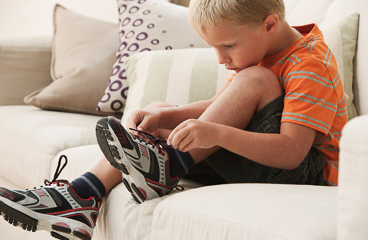Heel Pain in Children: Care Instructions
Overview

Heel pain can be from an injury or from everyday overuse, such as running or walking a lot. Plantar fasciitis
is the most common cause of heel pain. In this condition, the bottom of the foot from the front of the heel to
the base of the toes is sore and hard to walk on.
Your child's heel can get better with rest, anti-inflammatory pain medicine, and stretching exercises.
Follow-up care is a key part of your child's treatment and safety. Be sure to make and go to all
appointments, and call your doctor if your child is having problems. It's also a good idea to know your
child's test results and keep a list of the medicines your child takes.
How can you care for your child at home?
-
Have your child rest their feet often. Reduce your child's activity to a level that lets your child avoid
pain. Remind your child to not run or walk on hard surfaces.
-
Ask your doctor if you can give your child acetaminophen (Tylenol) or ibuprofen (Advil, Motrin) for pain.
Be safe with medicines. Read and follow all instructions on the label.
-
Put ice or a cold pack on your child's heel for 10 to 20 minutes at a time. Try to do this every 1 to 2
hours for the next 3 days (when your child is awake). Put a thin cloth between the ice and your child's
skin.
-
If ice isn't helping after 2 or 3 days, try heat, such as a warm cloth or hot water bottle. Keep a cloth
between the hot water bottle and your child's skin.
-
If the doctor says it is okay, teach your child these calf stretches. Tight calf muscles can cause heel
pain or make it worse.
-
Stand facing a wall with your hands on the wall at about eye level. Put the leg you want to stretch
about a step behind the other leg. Keeping the back heel on the floor, bend the front knee until you
feel a stretch in the back leg.
-
Stand about 1 foot from a wall. Place the palms of both hands against the wall at chest level and lean
forward against the wall. Put the leg you want to stretch about a step behind the other leg. Keep the
back heel on the floor and bend the front knee until you feel a stretch in the back leg. Hold this
position for 15 to 30 seconds. Repeat the exercise 2 to 4 times a session. Have your child do 3 or 4
sessions a day.
-
Sit down on the floor or a mat with your feet stretched in front of you. Roll up a towel lengthwise,
and loop it over the ball of your foot. Holding the towel at both ends, gently pull the towel toward you
to stretch the foot. Hold this position for 15 to 30 seconds. Repeat the exercise 2 to 4 times a
session. Have your child do 3 or 4 sessions a day.
-
Have your child wear a night splint if the doctor suggests it. A night splint holds the foot with the toes
pointed up. This position gives the bottom of the foot a constant, gentle stretch.
-
Have your child wear shoes with good arch support. Athletic shoes or shoes with a well-cushioned sole are
good choices.
-
Try a heel lift, heel cup, or shoe insert (orthotic) to help cushion your child's heel. You can buy these
at many shoe stores.
-
Help your child stay at a weight that puts less strain on the feet. Talk to your child's doctor if your
child needs help losing weight.
When should you call for help?
 Call your
doctor now or seek immediate medical care if:
Call your
doctor now or seek immediate medical care if:
Watch closely for changes in your child's health, and be sure to contact your doctor if:
Current as of: July 17, 2023
Content Version: 14.0
Care instructions adapted under license by your
healthcare professional. If you have questions about a medical condition or this instruction, always ask
your healthcare professional. Healthwise, Incorporated disclaims any warranty or liability for your use of
this information.